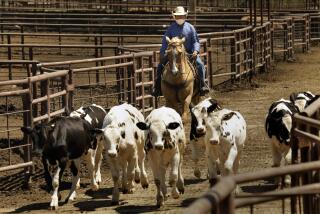FARM campaign pays viewers $1 to watch graphic anti-meat video
Acknowledging the existence of animal cruelty is unpleasant, and getting people to actually watch footage of it is understandably difficult. The folks at Farm Animal Rights Movement (FARM) found one way: Pay them.
Operating on the premise that watching a four-minute video could persuade a viewer to drastically and permanently reduce the amount of animal products consumed in their diet, FARM launched a national tour in early May to show the public a graphic âFarm to Fridgeâ video, made with hidden-camera footage showing farm animals, including cows, chickens and pigs, living in factory farm conditions and being processed at slaughter. Participants are paid $1 to watch the video, displayed on a vehicle specially equipped to host up to 32 simultaneous viewers.
The 10-Billion Lives Tour (named after the estimated 10 billion land animals raised and killed every year for food in the United States) began in Portland, Ore., and has traveled south, stopping at colleges, universities and fairs along the way in Eugene, Sacramento, San Luis Obispo and Santa Barbara. On Saturday the vehicle will be stopping in downtown Santa Ana at 6 p.m. for five hours.
FARM tour coordinator Jeni Haines says that the vehicle has already drawn 2,111 curious (or dollar-hungry) viewers to check out the video. Overall, Haines explains, the public has expressed acute reactions: anger about the conditions on factory farms, and a sense of gratitude that someone is connecting the dots â most participants, she says, reveal that they had no idea.
âPart of the reason is that we donât want to know â itâs a hard reality to face,â says Haines. âMost of us, like me, grew up eating meat, dairy and other animal products. When you have this great love for animals but donât realize where these products come from, it creates a big gap. And when you see a video like this and make that realization and that connection, it evokes a strong reaction.â
Through detailed follow-up surveys, FARM claims that an average participant in the video-viewing consumes 10 fewer animals per year after watching and that 60% of viewers maintained their pledge to eat fewer animal products.
So far, there have been no protests or counter-campaigns by meat producer advocacy groups at stops along the tour.
RELATED:
Sea Shepherdâs Watson arrested, faces extradition to Costa Rica
Whale Warsâ Paul Waton on Faroes killing, online debate
Federal judge blocks blocks National Defense Authorization Act provision






